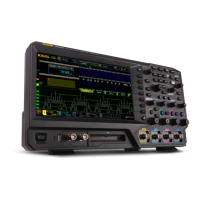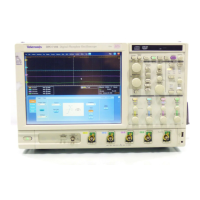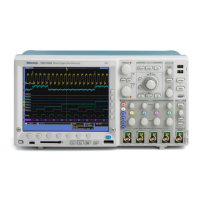Command Syntax
When concatena
ting commands and queries, you must follow these rules:
Separate completely different h eaders by a semicolon and by the beginning
colon on all commands except the first one. For example, the commands,
TRIGger:MODe NORMal and ACQuire:NU MAVg 10, can be concatenated
into the following single command:
TRIGger:MODe NORMal;:ACQuire:NUMAVg 10
If concatenated commands have headers that differ by only the last mnemonic,
you can abbreviate the second command and eliminate the beginning colon.
For example, you can concatenate the commands ACQuire:MODe ENVelope
and A CQuire:NUMAVg 10 into a single command:
ACQuire:MODe ENVElope; NUMAVg 10
The longer version works equally well:
ACQuire:MODe ENVElope;:ACQuire:NUMAVg 10
Never precede a star (*) command with a colon:
ACQuire:MODe ENVElope;*OPC
Any commands that follow will be processed as if the star command was
not there. For example, the ACQuire:MODe ENVElope;*OPC;NUMAVg
10 commands will set the acquisition mode to envelope and set the number
of acquisitions for averaging t
o 10.
When you concatenate queries, the responses to all the queries are
concatenated into a single response message. For example, if the display
background color is white and the display foreground color is black, the
concatenated query DISplay:COLor:BACKGround?;FOREGround? will
return the following:
Iftheheaderison:
:DISPLAY:COLOR:BACKGROUND 7;
:DISPLAY:COLOR:FOREGROUND 0
If the header is off:
7;0
Set commands and queries may be concatenated in the same message. For
example,
ACQuire:MODe SAMple;NUMAVg?;STATE?
is a valid message that sets the acquisition mode to sample. The message
then queries the number of acquisitions for averaging and the acquisition
state. Concatenated commands and queries are executed in the order
received.
Here are some invalid concate na tions:
DSA/CSA/TDS8X00/B Series Programmer Manual 2-11

